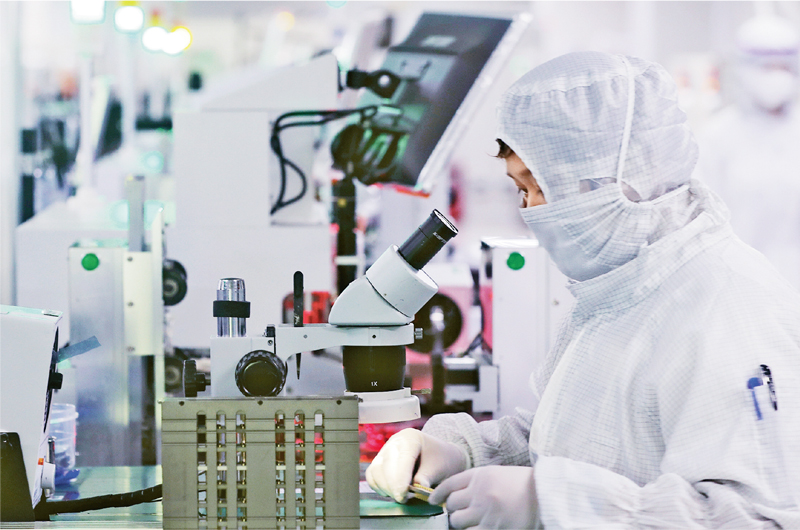Deepening cooperation between Guangdong, Hong Kong and Macao to develop the Greater Bay Area


To develop the Guangdong-Hong Kong-Macao Greater Bay Area (GBA) is an important decision of the Central Committee of the Communist Party of China (CPC) led by Xi Jinping. It is a strategic necessity for creating a model to guide China's high-quality development and continuing to make our economy more innovative and competitive, for optimizing locational functions and bringing about coordinated regional development, for building a new open economic system and a new platform for international economic cooperation that supports the Belt and Road Initiative, and for improving practical aspects of the "one country, two systems" policy so as to secure the long-term prosperity and stability of Hong Kong and Macao. Moreover, it is an important component of our efforts to achieve the Two Centenary Goals and the Chinese Dream of national rejuvenation.
The CPC Central Committee and the State Council released the Outline Development Plan for the Guangdong-Hong Kong-Macao Greater Bay Area (hereinafter "Outline Plan") on Feb 18, 2019, which marked a new phase in the construction of the GBA.
I. Pursuing innovation and enhancing technology and competitiveness
The intensity and extent of global technological innovation has been unprecedented since the beginning of the 21st century. The new round of scientific and technological revolution and industrial transformation is reshaping the global innovation landscape as well as the global economic structure. China has transitioned into a stage of high-quality development. While it actively responds to various risks, challenges, and bottlenecks, it has a great and urgent need for technological innovation. Never has science and technology had such a profound impact on the future and destiny of a country or on people's lives and wellbeing as it does today. The GBA is home to a high concentration of factors for scientific and technological innovation, with outstanding R&D and industrial application capabilities as well as nationally, and even globally, influential universities, research institutes, high-tech enterprises, and major national-level projects. All of this gives it the conditions to become an active participant and leader in the new round of global scientific and technological revolution and industrial innovation.
The Outline Plan identified the development of an international innovation and technology hub as a primary task. It proposed deepening cooperation on innovation between Guangdong, Hong Kong, and Macao, building an open and integrated regional collaborative innovation community, concentrating international innovation resources, and optimizing innovation systems and the policy environment, with a focus on improving the area's ability to convert scientific and technological achievements into real-world applications. In recent years, the Office of the Leading Group for the Development of the Guangdong-Hong Kong-Macao Greater Bay Area ("GBA Leading Group Office"), working with central departments and relevant regional and provincial governments, has established sound coordination mechanisms, driven technological innovation, improved institutional mechanisms, and promoted the construction of a modern industrial system.
Expanding scientific and technological innovation capabilities
The key to promoting scientific and technological innovation is to strengthen basic research and strategic scientific and technological capabilities, with the aim of converting those into practical applications that boost industrial development. In accordance with the CPC Central Committee and State Council's plan to develop an international technology innovation hub in the GBA, "two corridors" (the Guangzhou-Shenzhen-Hong Kong and the Guangzhou-Zhuhai-Macao innovation and technology corridors) and "two hubs" (the Lok Ma Chau Loop, which occupies a strategic location on the border of Shenzhen and Hong Kong, and Hengqin, which is located in Zhuhai in southern Guangdong and is next to Macao) have been developed. In addition, construction has begun on a pilot zone of the Comprehensive National Science Center in the GBA, and a number of major scientific and technological infrastructure and scientific research platforms are in the pipeline or being developed.
In terms of major scientific and technological infrastructure, the China Spallation Neutron Source has been put into operation, and work is accelerating on a high-intensity heavy-ion accelerator facility, a brain analysis and simulation project, synthetic biology research, and a large materials genome facility. Guangdong, Hong Kong, and Macao are cooperating on the construction of innovation platforms in fields including new materials, artificial intelligence, biomedicine, marine technology. The Peng Cheng Laboratory has been inaugurated, and the Hong Kong Institute of Science and Innovation, which is affiliated with the Chinese Academy of Sciences, has been established.
In the area of industrial innovation, initial results have been achieved in key core technologies such as microchips, and projects in areas such as 5G, ultra-HD video, and integrated circuits have successively gone into production.
Improving the innovation environment
Led by a problem-oriented approach and driven by technological and institutional innovation demand, efforts are being made to promote quick and efficient flows of science and technology innovation factors across borders as well as regulatory alignment. Channels for providing funding for scientific research to Hong Kong and Macao from the central government and Guangdong Province are already open, making national key R&D programs such as stem cell and transformation research and nanotechnology open to applicants from the two special administrative regions. The Guangdong-Hong Kong-Macao joint funding program for science and technology innovation is also steadily being implemented, and Hong Kong and Macao scientific research institutions and personnel now have access to major scientific and technological infrastructure and large-scale scientific research equipment in the mainland. The National Super-computing Center in Guangzhou has established network connections with Hong Kong and Macao, serving nearly 200 users. The import and export procedures for cross-boundary use of scientific research products have been simplified, with scientific research equipment from Hong Kong and Macao exempt from product certification. In addition, 24-hour customs appointments are available for large-scale scientific research equipment, with immediate clearance and on-site inspections, helping to accelerate customs clearance. A preferential income tax policy has also been implemented in the GBA to attract high-end overseas talent and badly-needed personnel.







